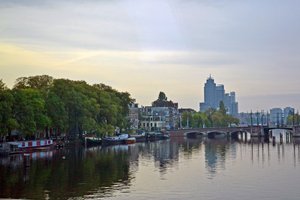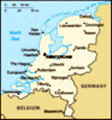Advertisement
Published: June 18th 2022

 Amstel River
Amstel River
Amstel River in the morning from the Torontobrug.
DSC_0562p1Amsterdam is inseparable from its canals. It is impossible to visit Amsterdam and not encounter the canals in some way. They form concentric rings around the city, radiating out from the harbor area. The outermost canals have defined the city limits over the centuries. As the city expanded, new canals were dug. The Prinsengracht defined the city limit in the 17th century. By the 19th century, the city had expanded outward and the Singlegracht then formed the boundary.
Construction of the inner canal belt system began in the 16th century and continued into the 17th century coinciding with the rise of Amsterdam as a world commercial and shipping capital. During this era, the Dutch Golden Age, merchants and the well-to-do commissioned grand townhouses along the canals in the distinctive Dutch Renaissance style. The canals were meant to support commercial traffic, connecting business with the harbor, very much like the canals of Venice. Like Venice, some of the canals have been filled in over the year and become streets. Unlike Venice, motor vehicles, trams, and cyclists use the streets running alongside and over the canals.
A ride on the Amsterdam canals was set for Sunday morning. The quay for the

 Amsterdam Centraal
Amsterdam Centraal
Amsterdam Centraal - Amsterdam Central Station. Designed by Pierre Cuypers with the distinctive roof designed by L.J. Eijmer. Gothic/Renaissance Revival style, opened in 1889. Stationsplein 15.
"In the centre, on one of these islands, lies the Central Railway Station, a large building in the Dutch Renaissance style, designed by P. J. H. Cuypers and opened in 1885".--Baedeker 1910
DSC_0575p1canal cruise boat was right down by Centraal Station. A good chance to inspect the architecture of this grand railway terminal, done up in the Dutch Renaissance Revival style popular in the 1880s. (No time for train spotting, though.) It fit in well with its surroundings.
The canal cruise took us around over Prinsengracht, Leidsegracht, Herengracht, the Amstel River, Oudeschans, and out into the Oosterdok. It was a great way to see old Amsterdam, a part of the Jordaan, and all the new building activity in the harbour area, all from water level. Amsterdam seems to be reusing its former harbour dock area for new building construction. I can only conclude other means have been found to support seagoing trade or it has moved away from central Amsterdam altogether.Amsterdam Centraal Station (1882).The 21st century structures offer a contrast with the 17th to early 20th century buildings lining Prins Henrikkade across the way.
Townhouses in the Dutch Renaissance style line all of the older canals. They range from mansions along Herengracht to simpler, but no less attractive, houses and businesses lining Prinsengracht. Along newer canals like Singlegracht, one finds 19th century buildings, parks, hotels, restaurants and museums in a

 Bicycle Parking Garage
Bicycle Parking Garage
Bicycle parking garage next to Ameterdam Centraal.
DSC_0578variety of styles. A surprise is the number of houseboats on the canals. They are in all styles, from ones that look like boats to ones that look like floating boxes. The city has imposed a cap on new houseboats, so in order to own one, you have to buy an existing one. Thus, supply is limited and they can be very expensive! The inhabitants personalize them will all sorts of decorations and plantings.
The canals can be explored at street level on foot or bicycle. Or you can explore them by sailing on the canals themselves. There are two ways to do this. The Canal Bus runs three hop-on, hop-off lines from Central Station as far as Museumplein. There are also narrated canal sightseeing tours operating similar style boats. Either way, I really recommend seeing the canals at water level! I liked the way each canal house has a hook at the top for lifting items to the upper floors. Houses are narrow and space at a premium, so there is no room for wide stairs to bring things up from the inside. I have to say I did not know there were so many houseboats on the

 Merchant Townhouses
Merchant Townhouses
Building with facade under cut straight list of consoles. 19th century. Prins Hendrikkade 12.
Building with heavy gable, "Anno 1740". Prins Hendrikkade 14.
DSC_0579canals here. (Their number has recently been limited.)
The "Seventeenth-Century Canal Ring Area of Amsterdam inside the Singelgracht" is a UNESCO World Heritage Site.
I must also make special note of the multilevel bicycle parking garage adjacent to the railway station. I understand commuters keep their bikes here and ride them to work when they come into town. I was told that bike theft is a problem around town. Owners need to keep their bikes double locked or thieves will steal the bike frame and leave the front wheel, or vise-versa. Then they put a whole bike together from the parts! Unbelievable! Why, I thought Amsterdamers would be better behaved! Truly, I did see many a front wheel hanging locked by itself and the rest of the bike missing!
From the Canal Belt, next on the agenda was the Rijksmuseum. The Rijksmuseum is one of the world's great art museums and a must-see for visitors to Amsterdam. We spent several hours here after our canal excursion. The museum is home to a comprehensive collection of Dutch Old Masters paintings from the Dutch Golden Era as well as other periods, including an Asian art collection. The museum was

 Eye Film Institute
Eye Film Institute
Eye Film Institute. IJpromenade 1.
DSC_0587p1closed from 2003 to 2013 for a complete renovation.
The striking building immediately catches one's eye. It was designed by Pierre Cuypers in his signature combination of Renaissance and Gothic styles opened in 1885. An unusual feature is the breezeway, known as the Passage, that connects Museumplein and Stadhouderskade through the middle of the building. The Passage of open to pedestrians and cyclists, but pedestrians must on guard for the speeding cyclists!
Upon entering via a covered atrium, visitors ascend to the Great Hall where stained glass windows depict characters from Dutch life. This leads to the Gallery of Honour, the display of Dutch Masters, including Hals, Vermeer, Rembrandt and others. At the far end is Rembrandt's masterpiece, The Night Watch.
Visitors can go in several directions from the Night Watch Gallery. We elected to see the decorative arts galleries. An interesting presentation is made on the influence of Chinese blue porcelain brought back by the Dutch East India Company (VOC) on the development of Delftware. We enjoyed lunch in the cafe overlooking the atrium.
Advertisement
Tot: 0.303s; Tpl: 0.016s; cc: 23; qc: 88; dbt: 0.1568s; 1; m:domysql w:travelblog (10.17.0.13); sld: 1;
; mem: 1.3mb
























D MJ Binkley
Dave and Merry Jo Binkley
Netherlands
A beautiful city.